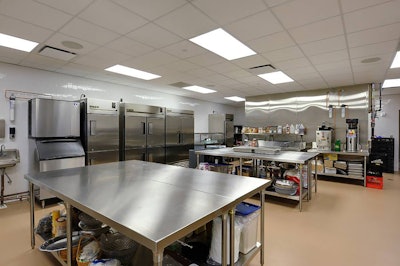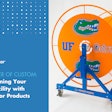
When planning a new municipal recreation center, the majority of initial design discussions focus on the big picture: How large will the gymnasium be? How many group exercise rooms are needed? What is the recommended size of the fitness center?
Those questions (and countless others) absolutely deserve the attention you give them. But it’s also critical to place early emphasis on facility components that can easily be overlooked and relegated to “we can always figure that out later” status. Failing to plan accordingly at the outset for ancillary spaces that many patrons take for granted, however, could result in design dilemmas and even construction delays.
Three of the most common recreation facility components that often don’t receive enough pre-planning attention — yet should be addressed as early as possible to save time, money and stress — are food and beverage service options, aquatics mechanical/chemical rooms and storage.
In this blog post, I’ll explore ways to plan and implement food service strategies; in future posts, I’ll cover design strategies for aquatics mechanical/chemical rooms and general storage areas.
How much food and drink should you offer?
 Brinkley Sargent Wiginton Architects
Brinkley Sargent Wiginton Architects
Granted, food and beverage service is a broad topic — which is exactly why you need to give it some serious thought early on. Options range from concessions stands and vending machines to third-party providers like Subway and Smoothie King to full-service commercial kitchen setups.
The facility’s business plan will help determine the direction you take regarding food service operations. If the plan is to provide nothing more than snack options for patrons, you might simply go with vending machines. In that case, figure out how many machines you need, what they will dispense and where they will they be located. If you really want to simplify things, consider only offering those items at the control desk, where nonperishables like energy bars and snacks are kept along with a cooler filled with water and sports drinks. Maybe add a small coffee counter, too, with cups available at the desk.
The next step up from vending machines is a concessions area. Its size will be based on how much variety you plan to offer. If the plan is to offer only pre-packaged items, there will be little need for much more than coolers and a microwave or two. A greater variety of food and drink options will require more space, more equipment and more electrical outlets. Small warming appliances such as air fryers and hot dog rollers can often be incorporated without triggering much more substantial investments when crossing the threshold into cooking and plating. (More on that option below.)
Other considerations when creating a concessions area: Where will the service window or counter be located, and how large will it be? Will there be a small seating area or will a grab-and-go approach suffice? How much equipment will be necessary, and how many employees will be required to staff the concessions area? What will its hours of operation be, and can it be accessed easily by vendors delivering product?
 Brinkley Sargent Wiginton Architects
Brinkley Sargent Wiginton Architects
If all that seems like too much of a hassle, some facility owners consider partnerships with a restauranteur to set up shop in the facility. Third-party concessionaires can find success in collegiate recreation centers, but it is more difficult to succeed in municipal recreation facilities. The caveat is that the owner typically must guarantee the concessionaire a minimum amount of revenue in order to make the operation worthwhile; in most cases, that translates into a subsidy that ultimately fizzles out.
Facilities designed with the intention to host large events, community meetings and cooking classes typically require a full-service commercial kitchen, complete with cooking and even walk-in freezers and ware washing. In that case, it’s a good idea to bring in a food service consultant, who can help with everything from capacity and menu options to food strategies and overall design.
In short, the level of indoor food service your facility provides will be driven by the facility’s mission, patron needs and logistics.
Outdoor aquatics: Make way for food trucks
Outdoor aquatics facilities tend to pivot on one of two models: Provide vending and allow patrons to bring in their own coolers or provide concessions. With a captive audience that likely will spend several hours onsite, it makes sense to concession a variety of food and drink options. Most facilities that do so also ban carry-ins; otherwise, they’re undermining their own concessions operations.
While outdoor concessions stands can be profitable, I’m seeing more aquatics venues designed to accommodate food trucks. This is especially effective for special events. Think of them as temporary concessions stands that you don’t have to maintain. Planning for food trucks involves designing a large service drive with a wide gate to provide trucks access to deck areas. With food trucks on pool decks, the concrete must be strong enough to withstand the additional weight, and power poles or bollards need to be provided.
In any case, designing with food trucks in mind is becoming the new normal for mid-size and large outdoor municipal aquatic facilities. Mobile vendors have revitalized the food truck business, making them reliable, clean and even healthy options for facilities that want to expand their food service choices for special programming and events.
At its core — and depending on the level you offer — food and beverage service at a municipal recreation center is likely to emerge more as a goodwill generator than a revenue driver. It’s a service you provide to keep patrons happy and coming back for more. And when it’s done right, they will.
Next time, I’ll cover design strategies for aquatics mechanical/chemical rooms.
Stephen Springs, FAIA, is a senior principal at Brinkley Sargent Wiginton Architects in Dallas, Texas.





































